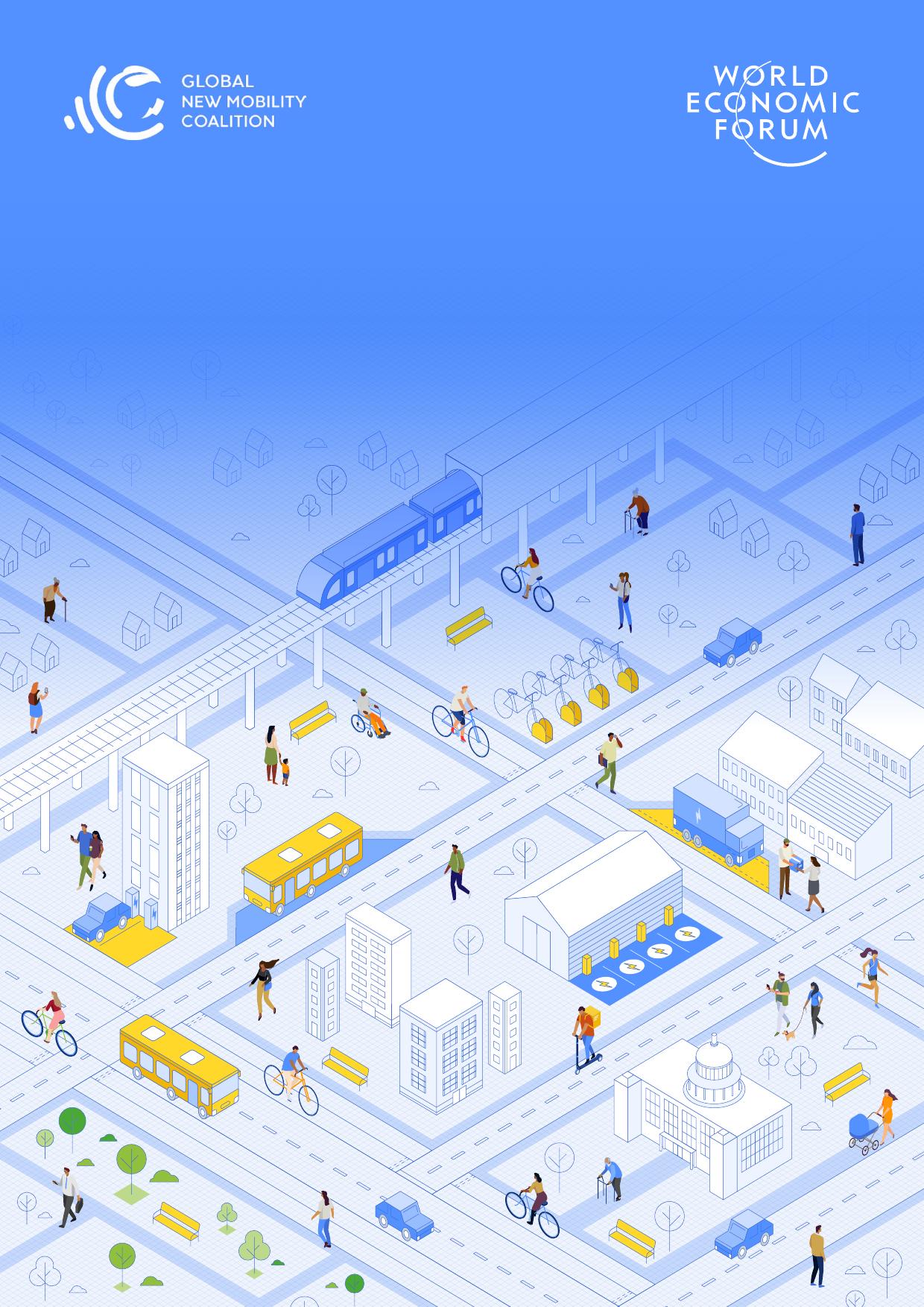IncollaborationwithVisaTheUrbanMobilityScorecardTool:BenchmarkingtheTransitiontoSustainableUrbanMobilityBRIEFINGPAPERMAY2023Images:GettyImagesContentsForeword31Introduction42�TheUrbanMobilityScorecardTool:Benchmarkingthe7transitiontosustainablemobility3�Collaboratingwithcities104�Learningsandnextsteps17Conclusion19Contributors20Endnotes21DisclaimerThisdocumentispublishedbytheWorldEconomicForumasacontributiontoaproject,insightareaorinteraction.Thefindings,interpretationsandconclusionsexpressedhereinarearesultofacollaborativeprocessfacilitatedandendorsedbytheWorldEconomicForumbutwhoseresultsdonotnecessarilyrepresenttheviewsoftheWorldEconomicForum,northeentiretyofitsMembers,Partnersorotherstakeholders.©2023WorldEconomicForum.Allrightsreserved.Nopartofthispublicationmaybereproducedortransmittedinanyformorbyanymeans,includingphotocopyingandrecording,orbyanyinformationstorageandretrievalsystem.TheUrbanMobilityScorecardTool:BenchmarkingtheTransitiontoSustainableUrbanMobility2May2023TheUrbanMobilityScorecardTool:BenchmarkingtheTransitiontoSustainableUrbanMobilityForewordThecitiesofthefutureneedtomovemorepeoplewithfewer,cleanervehicles.Investmentinelectrification,publictransportandsharedmobilityisthesolution.JeffMerrittDouglasSaboHeadofUrbanTransformation,ChiefSustainabilityWorldEconomicForumOfficer,VisaBy2050,almost70%ofpeoplewillliveinurbanandconnectedpublictransport,improvedareas,withtownsandcitiesexpectedtogrowinfrastructureandpriorityforcyclingandwalking,by2.5billionpeopleoverthatperiod.1Inanandintegrationofemergingmobilitysolutionssuchincreasinglyurbanizedworld,deliveringhealthy,assharedmobilitytocreateasuiteofoptionstoinclusive,sustainableandvibrantcitiesisvitalmeetthewide-rangingneedsofpeoplemovingforbothpeopleandplanet.Whenitcomestoaboutcities.Itisonlywithacombinationoftheseachievingthisvisionforcitiesofthefuture,thereissolutionsthatwecancutemissionstoaddresstheperhapsnosectormoreimportantthanmobility.urgentclimateemergency,reducethenumberofvehiclesontheroadtomakeourstreetssaferandTransportisthelifebloodofcities,providingaccesstomoreaccessible,allwhiletransportingagrowinghomeandwork,connectingustoourcommunitiesurbanpopulation.andlovedones,andgivingusthegoodsandservicesthatfueloureverydaylives.AscitiesgrowNoonecity,oronecompany,canachievethisandevolve,somustourtransportsystems.visionalone.Throughstrongpublic-privatecollaboration,wecanfindinnovative,impactfulandThelegacyoftransportpolicydecisionsinthe20thcontext-sensitivesolutionsformobilitytoenableacenturypresentsmajorchallengesforcities–fromsustainablefutureforcities.congestionandroadsafetytoairpollutionandemissionsacceleratingclimatechange.TorisetoTheGlobalNewMobilityCoalition’sUrbanMobilitythechallengeofdeliveringsustainableandinclusiveScorecardToolistestamenttothepowerofplacestoliveandwork,citiesarenowembracingpublic-privatecollaboration.Aproductofdeeptheopportunitiesofclean,efficientandinclusiveengagementwithcities,theprivatesectorandtransportsystems.civilsociety,thescorecardisaresourcethatcanhelpcitiesbenchmarkandaccelerateprogressonElectrificationisacrucialcomponentofthemodernsustainableandinclusiveurbanmobility.sustainabletransportecosystem.However,electrifyingprivatevehiclesisnotenoughtoachieveThemultisectoral,multidisciplinaryandtheemissionsreductiontargetsagreedintheParisgeographicallydiversemembersoftheGlobalAgreementonclimate.InordertocreatemoreNewMobilityCoalitionhavealreadybeenleadingequitable,liveableandhealthycities,adiversethewayindividuallytothesustainablefuturewerangeofapproachesisrequired.envision.Workingtogether,however,wecancreatethecitiesofthefutureonwhichthehealthofourElectrificationneedstobeacceleratedinsyncwithglobaleconomy,peopleandplanetdepends.apowerfulpushtowardsmoreefficient,accessibleTheUrbanMobilityScorecardTool:BenchmarkingtheTransitiontoSustainableUrbanMobility31IntroductionThereisnopathwaytomeetingtheParisAgreementclimategoalswithoutelectrifyingurbantransport,growingsharedtransportuseanddesigningmorecompactcities.Transformingurbanmobilitycanmean2.1billionpassengervehiclesemittingbringhugebenefitsforclimate,4.6billiontonsofcarbondioxideby2050.2healthandeconomiesButthereisanotherway.GrowingtheuseofAscitiescontinuetogrow,theshifttowardsmoreshared,electric,connectedandautomated(SEAM)sustainableurbanmobilitywillplayacriticalroletransportmodesandashifttomorecompactcitiesinourjourneytolimitglobalwarmingbelow1.5C.couldreduceprojectedvehiclenumbersin2050toHowever,currenttrendsintransportaredaunting:justhalfabillion.3ThisinturncouldslashemissionsBymid-century,demandforurbantravelissettofrompassengervehiclesby80%comparedtoadouble.Alongourcurrenttrajectory,thatwouldbusiness-as-usualscenario–reducingtheamountofCO2intheatmosphereby3.9billiontonsayear.BOX1Benefitsofadoptingashared,electric,connectedandautomated(SEAM)approachtourbanmobilityby2050–Reducevehiclesfromapotential2.1billion–Decreasemeasuredmobilitycostsby40%to0.5billion–Save~$5trillionperyear–Mitigate>80%ofCO2frompassengertransportSource:Fulton,L.,Mason,J.,&Meroux,D.(2017)4–Freeup75%ofurbanpublicspaceThebenefitsofaSEAMstrategywouldreachfarsharedtransportcanmaximizeopportunitiesforbeyondmitigatingclimatechange.Today,passengeremissionsreductionswhilecreatingmoreliveablevehiclescauseoverhalfofurbanairpollution,whichcities.Crucially,compactcitiesalsoofferanledtoanestimated1.8millionexcessdeathsin2019opportunitytorevitalizeurbanareas,creatingmoreandnearly2millioncasesofasthmainchildren.5economicallyviablecommunitiesbyenhancinglocalElectrifyingtransportwilldelivercleaner,healthierairforservicesandencouragingmixed-usedistricts.citydwellers.Additionally,fewervehicleswillreducecongestionanddecreasetheneedforexpensiveUrbanMobilityScorecardsmotorways,parkingandmaintenance.Estimatedcostinitiative:BuildingconsensussavingsofembracingaSEAMstrategytotheworld’sandbenchmarkingprogresseconomycouldtotal$5trillionayearby2050.6ThechallengefacingcitiesistoshifttowardsanewElectrificationalonecannotdelivertheseresults.modelofurbanmobilityinwhichelectrified,sharedThekeyliesinthesynergybetweenelectrification,transportbecomesthenorm.Tosucceed,thisincreasingtheuseofsharedtransport(suchastransitionneedstobeequitableforallcitydwellerspublictransport,sharedvehiclesandmicromobility)andmustembraceawiderangeofpartners,andcreatingmorecompactcities.Thetransportincludingtheprivatesector,cityadministrationsandsectorisresponsibleforaround60%ofglobaloilcivilsociety.demand,soacceleratingthetransitiontoelectricvehicles(EVs)isanessentialpriority.SyncingTheWorldEconomicForum’sGlobalNewMobilityelectrificationwithatransitiontosharedtransportCoalition(GNMC)isuniquelysuitedtotacklethiscan,however,deliverareductioninemissionswhilechallengebyfacilitatingdialoguebetweenthetacklingwiderissuessuchascongestion,safetyprivatesector,publicorganizationsandNGOstoandinefficientspaceallocation.identifytherootchallengesandpracticalsolutions,manyofwhichcrossbordersandsectors.Equally,designingmorecompactcitiesthatenableandprioritizeactivemobility(walking,cycling)andTheUrbanMobilityScorecardTool:BenchmarkingtheTransitiontoSustainableUrbanMobility4BOX2TheGlobalNewMobilityCoalitionTheWorldEconomicForum’sGlobalNewMobilityMembersandknowledgepartnersoftheGNMCCoalition(GNMC)seekstoaccelerateasynchronizedincludeplayersfromacrossnewandtraditionaltransitiontoshared,electric,connectedandmobilitysuchasoriginalequipmentmanufacturersautonomousmobility(SEAM)solutionstoprovide(OEMs),ride-hailing,micromobility,utilities,forhealthiercities,reducecarbonemissionsanddeliveryandinfrastructurecompanies,aswellasimprovemobilityefficiency,whilecreatingnewcityadministrations,academiaandcivilsocietybusinessopportunities.GNMCisamultistakeholderexperts.Todate,thecoalitioncomprisesmorecoalitionthatadvancesindustryandpolicythan40organizationsin17countries.collaborationforinformingefficient,impactfulandfeasibleactionsthatcanadvancethevisionforpeople-centred,compactandelectrifiedcities.TheinitiativeTheGNMC’smostrecentflagshipefforttoaddressBenchmarkprogressaimstohelpcitiesthischallengeistheUrbanMobilityScorecardsidentifystrengthsinitiative.LaunchedattheAnnualMeeting2022in–Developauser-friendlyscorecardtool,trialledandgapsinMay,theinitiativeaimstosupportcitiesandoperatorswithcitiesandbackedbytheprivatesector,urbanmobility,tomeettargetsforsharedanddecarbonizedmobilitytohelpcitiestrackprogresstowardsshared,understandbarriersthroughthedevelopmentofascorecardassessmentelectricandconnectedmobilitytoprogressandtool,andfacilitateddialoguestobridgethegapsraiseambitionbetweencities,NGOsandtheprivatesector.ThroughThroughadedicatedWorkingGroup,aswellasonadvancingthesetwoareas,theScorecardsinitiativeaimstohelpin-personandvirtualevents,stakeholdersfromsustainablecitiesidentifystrengthsandgapsinurbanmobility,acrosstheprivatesector,citiesandNGOs,haveurbanmobility.understandbarrierstoprogressandraiseambitionbeenengagedthroughouttheinitiative.Theseonadvancingsustainableurbanmobility.dialoguesservedtwokeypurposes.First,theyguidedandinformedthedevelopmentofadigitalTheinitiativewascreatedtoprovideauniquescorecardtool(seebelow),seekingtolearnfromaofferingtostimulatedialogueandactionondiverserangeofexpertsinthemobilitysectorandurbanmobility:embedlivedexperiencesandchallengesinadigitaltoolforcities.Second,theystimulateddiscussionConnectpublicandprivatestakeholdersandanexchangeofperspectivesonkeyissuesholdingbackactiononurbanmobility,suchas–Createneutralplatformsthrougheventsandrolesandresponsibilitiesforthepublicandprivateworkshopsthatopenupspaceforcities,NGOssectorindeliveringservicesandinfrastructure,andprivatemobilityoperatorstodiscusssharedandtacklingsiloedapproachesholdingbackthechallengesandexploresolutionstransitiontowardsmoreequitableandsustainableurbanmobility.–BringtogetherdiversestakeholderstoexpandperspectivesandincreaseawarenessofDevelopedthroughdeepstakeholderengagement,innovativeapproachesandlearningsfromthetheUrbanMobilityScorecard(UMS)Toolisapublicandprivatesectorsquestionnaire-basedassessmentforcitiestobenchmarkprogressonsustainableurbanmobility.Supportdecision-makingThetoolhasnotonlybeenguidedandshapedbyprivatesectorperspectivesandexperiencesbut–Supporturbanmobilitydecision-makingbyalsohasbeeninformedbyandtrialledwiththreebuildingabroad-basedconsensusonrolesandleadingcities.responsibilities,anddevelopingcollaborativewaysofworkingTheUrbanMobilityScorecardTool:BenchmarkingtheTransitiontoSustainableUrbanMobility5BOX3PrinciplesunderpinningtheUrbanMobilityScorecardsinitiative–Equitable:Transportshouldbeaccessible,–Multimodal:Designingasystemwhereitisinclusiveandaffordableforallpeople,easytousemanydifferenttypesoftransport,regardlessoftheirsocio-economicstatusorwithouthavingtoresorttoprivatevehicleswheretheylive–Zero-emissions:Shiftingtotheelectrification–Context-specific:Thereisnoone-size-fits-allofalltransportisavitalpriority,alongwithsolutiontosustainableurbanmobility;eachencouragingtheuseofmoreshared,publiccityhasitsownspecificchallengestosolveandactivemodesoftransportandsolutionstoimplementFIGURE1SummaryfromGNMCdialogueattheUrbanTransformationSummit,October2022Source:WorldEconomicForum,UrbanTransformationSummit,Detroit,USA,October2022TheUrbanMobilityScorecardTool:BenchmarkingtheTransitiontoSustainableUrbanMobility62TheUrbanMobilityScorecardTool:BenchmarkingthetransitiontosustainablemobilityAtooltohelpcitiesassessprogressonsustainable,inclusiveurbanmobility.AimsandscopeoftheUrbanFeaturesoftheUMSToolinclude:MobilityScorecardTool–Mobilityassessments:Sevenquestionnaire-TheUrbanMobilityScorecardToolisadigitaltoolbasedassessmentstoevaluatecities’progressallowingcitiestotakeassessmentsandbenchmarkonsustainable,inclusivemobilitytheirprogressonsustainableandinclusiveurbanmobility.Thetoolallowscitiestounderstand–Benchmarkingofresults:Anonymizedstrengthsandweaknesses,acknowledgekeycomparisonofcities’resultstobenchmarkachievementsandidentifyareaswhereactioncanprogressonmobilitybetaken,forexample,throughpolicy,regulationorpublic-privatecollaboration.Ittakesaqualitative,–Actionsetting:Basedonresults,takestepstoquestionnaire-basedapproachtoenablecityadvanceactionindifferentareasofurbanmobilityadministrationstoassesstheunderlyingpolicies,strategiesandsystemsinplacethatsupport–Supportingresources:Compiledresources,sustainableurbanmobility.casestudiesandbestpracticestosupportandinspirefutureactionRatherthanseekingtobearankingorratingofcities,thetoolactsasanaidforcitiestoDevelopedindeepconsultationwiththeprivatebenchmarktheirprogress,exploresolutionssectorandcivilsociety,thetoolisameanstoandassistindecision-making.Byshowcasingbridgethegapbetweencitiesandthelivedbestpracticesfromacrosstheworld,thetoolexperiencesofprivateandnon-governmentalalsodrivesawarenessofinnovativeapproachesmobilitystakeholderstodevelopajointandencouragesactionfrombothpublicandunderstandingofbarriersandopportunities.privatesectors.TheUMSToolisstructuredaroundthethreepillarsofGovernance,ResilienceandConnectivity,exploredinfurtherdetailbelow,alongwiththeseventhemesencompassedwithinthosepillars(seeFigure2).TheUrbanMobilityScorecardsinitiativehascreatedinvaluableopportunitiesforactionablecollaborationwithotherleadersinthemobilityspace.Theinitiative’ssharpfocusonhelpingcitiesidentifyclearpathstomoresustainableurbanmobilitycanleadtomeaningfulchange,advancingsustainableandinclusivemobilityforall.NickMackie,Vice-President,GlobalHeadofUrbanMobility,VisaTheUrbanMobilityScorecardTool:BenchmarkingtheTransitiontoSustainableUrbanMobility7Pillar1:GovernanceTheGovernancepillaraddressesthesystemsTheGovernancepillarisdividedintothreesupportingurbanmobility.Theaimofthispillarisprincipalthemes:toexplorehowchangesingovernancecouldbeleveragedtocreatemorenimble,adaptableand–Institutionalcoordination(e.g.,masterplanning,future-ready,urban-mobilityecosystems.Thevisioninvestmentandbudget,internalcapacity)ofsupportivegovernanceinthescorecardtoolisastructureunderpinnedbycoordinatedinstitutions–Regulation(e.g.,urbanvehicleaccess,dataandoperatorsworkingwithinaresponsiveandup-accessandsharing)to-dateregulatoryenvironmentthatisinnovativeinresponsetochangesinmobility.–Innovation(e.g.,enablingsharedmobility,pilotprojectsandtenders,electrificationandcharging)Pillar2:ResilienceTheResiliencepillartacklesoperationalTheResiliencepillarisdividedintotwoprincipalpriorities.TheUMSTool’svisionofresilienceisthemes:mobilityinfrastructurethatofferssafe,efficientmovementofpeopleandgoodsthroughasystem–Spaceallocation(e.g.,spaceforcyclingandmicro-designedtoprioritizeandencouragesustainablemobility,walkability,publicandsharedtransport)modesoftransport,withastrongmodaldiversityandflexibility.–Kerbsidemanagement(e.g.,parking,loadingandfreight)Itishearteningtoseeatoolbeingdevelopedtoencourageadoptionofsustainablemobilityinurbanareas.AsanOEM,weseeimmensevalueininteractingwithglobalcities.Theyhavethepotentialtobecomefreight-smartbytransitioningtogreeneralternativessuchaselectrictrucks.PulkitSrivastava,Co-Founder,EVAgePillar3:ConnectivityTheConnectivitypillarhasaparticularfocusontheTheConnectivitypillarisdividedintotwoprincipalprioritiesofaccessible,inclusiveandequitableurbanthemes:transport.TheUMSTool’svisionofconnectivityisacitythatiswell-connectedbymultiplemodesof–Integration(e.g.,multimodalintegration,mobilitytransport,offeringconvenient,attractiveoptionsforpaymentsandticketing,informaltransport)public,sharedandelectricmobility,whichiseasilyaccessibleandaffordableforall.–Equitableaccess(e.g.,accessibility,accesstomobility,road-usersafety)TheUrbanMobilityScorecardTool:BenchmarkingtheTransitiontoSustainableUrbanMobility8FIGURE2UMSToolFrameworkInnovationRegulationGovernanceInstitutionalcoordinationKerbsideResilienconneEquitablemanagementctivityaccesseCSpaceallocationIntegrationDevelopingtheUrbanMobilityexperiencesandchallengesofpublicandprivateScorecardToolstakeholdersindeliveringsustainablemobility,drawingoutkeylearningsonthefactorsneededtoThedevelopmentoftheUrbanMobilityScorecardadvanceactiononsustainableurbanmobility.ThisToolhasbeenacollaborativeeffortwithpartnersofwascoupledwithanin-depthreviewofmorethantheWorldEconomicForumandkeystakeholders20relevantsustainableurbanmobilityframeworksfromtheGNMCcommunity.TheScorecardsandindiceswerereviewedtounderstandtheinitiativeWorkingGroup–representingsectorsimportantthemesandmetrics,thediversityofsuchasOEMs,ride-hailing,micromobility,utilities,issuestoconsiderandthemeritsofdifferentdeliveries,digitalpaymentsandinfrastructure,asmethodologicalapproaches.7wellascivilsocietygroups–wascentraltothedevelopmentofthecontentofthescorecardtool.Thisin-depthresearchunderpinningtheUMSTool,withacentralfocusonreal-worldpublicandThroughdesign-thinkingworkshopsandinterviewsprivateexperiences,informedthedevelopmentofwithWorkingGroupmembers,aswellasin-adetailedframeworkandthesevenquestionnaire-personevents,thesesessionsfocusedonthelivedbasedassessmentsthatformthebasisofthescorecardtool.Itwasimportantforusthatthetoolshouldworkforsmallercities,thatitshouldcontemplatepopulartransportmodes,whicharesocommonintheGlobalSouth,andthatitincludedinclusioncomponentssuchasagenderperspective.Wehopethistoolisusefulforadiversityofcitiesaroundtheworldandthatitcancontinuetobeimprovedascitiestryitout.AndreaSanGilLeon,Co-Founder,AgileCityPartnersTheUrbanMobilityScorecardTool:BenchmarkingtheTransitiontoSustainableUrbanMobility93CollaboratingwithcitiesCitiesleadthewayintakingactiononsustainablemobility–theyarewell-placedtotrialnewsolutionsandcollaboratewiththeprivatesector.Collaborationwithdiversecitieswithaninnovativeapproachtopublictransport,willdeepentheUMSTool’sactivemobilityandtrafficmanagementtakingapplicabilityandextenditsreachcentre-stage.Singaporeisaimingtocontinueitsleadershiponsustainablemobilitythrough,forAtCOP27inNovember2022,theGNMCexample,electrificationanditsshifttowardsmoreannouncednewcollaborationswithcitiestoinformpublictransport.andtrialtheuseoftheUrbanMobilityScorecardTool–BuenosAires,Argentina;Curridabat,CostaCityRoundtablesRica;andSingapore.TheprioritywasWhenlookingforpartnercitiestotrialandAspartoftheUrbanMobilityScorecardstocollaboratewithco-developtheUMSTool,theprioritywastoinitiative,theGNMCco-hostedmultistakeholderadiverserangecollaboratewithadiverserangeofcitiestobuildroundtableswithitstrialcitiesinMarch2023.Ledofcitiestobuildanunderstandingofthedifferentchallengesanddevelopedbycitiesthemselves,theaimofanunderstandingthatvarioustypesofcitiesfaceandthedifferenttheroundtableswastoshineaspotlightonlocalofthedifferentperspectivestheyadopt.Theycanbelargeorsmall,challengeslinkedtosustainableurbanmobilityaschallengesthathigh-,middle-orlow-income,leadersinsustainableidentifiedbythecityandincooperationwithkeyvarioustypesmobilityorlookingtotaketheirtransitionfurther.stakeholders.TheroundtableswereattendedbyofcitiesfacerepresentativesfromorganizationsspanningmobilityandthedifferentThecontrastingperspectivesandcontextsoftheseoperators,infrastructureproviders,industrygroups,perspectivesthreecitieswasessentialinshapingtheUMSToolacademia,civilsocietyandcityadministrations.theyadopt.intoanapproachwithglobalapplicability.ThesethreetrialcitiescanserveassignpostsforothercitiesTheroundtablesfacilitatedpublic-privatetakingstepstocreateamoresustainablefuture.collaborationinsupportoflocalapproachestoadvancingdifferentissueswithinsustainableEachofthethreetrialcitiestocollaborateinthemobility.DiscussionscentredonissuessuchasdevelopmentoftheUrbanMobilityScorecardTooladvancingsharedmobilityasameanstotacklebringsitsownuniquecontextandapproachtocardependency(e.g.,sharedvehicles,publicurbanmobility:transport);improvingconnectionsbetweenactivemobilityandpublictransport(e.g.,footpathsBuenosAires:ThecapitalofArgentinaisseekingandcyclelanesthatconnecttobuses,metros,toenhancesustainablemobilitytokeeppeopleetc.);andacceleratingtheelectrificationofurbanmovingwhileofferingmoreconnected,integratedtransportandcharginginfrastructure.transport.Thecityisembracingnewsolutionstoreduceprivatecardependencyandprovideawell-Theroundtablesalsofocusedonwaysofintegrated,multimodaltransportsystem.addressingthesechallenges,includingrolesandresponsibilitiesindeliveringsustainablemobility,Curridabat:LocatedinthemetropolitanregionofSaninvestmentandthefinancingneeded,relationsJosé,CostaRica,Curridabatisaimingtobealocalandalignmentbetweenlevelsofgovernment,leaderinsustainablemobility.Thecityisembracingandtheneedforajointunderstandingandinnovativeapproaches,suchasnature-basedsharedvisionbetweencitiesandtheprivatesolutionsinurbanplanning,aswellasadvancingsector.Providingtheseplatformsofferedvaluableactiononactivemobilityandpublictransport.opportunitiesforcitiestosharetheirambitionsandchallengesandengagewithkeyplayersinSingapore:ThecitystateofSingaporeisatheurbanmobilitytransition,encouragingfutureleaderinthetransitiontosustainablemobility,collaborationandengagement.TheUrbanMobilityScorecardTool:BenchmarkingtheTransitiontoSustainableUrbanMobility10FIGURE3Avisionofurbanmobilitythatiscompact,shared,connectedandelectrifiedSafe,connectedSpaceprioritizedforVehicleaccessspaceforwalking,shared,connectedregulationstolimitcyclingandandpublicmodestrafficandpollutionmicromobilityAsafe,accessibletransportsystemforallCity-wideAflexible,innovativeEmbracingnewchargingnetworksapproachtopilotingsolutionsforforpassengernewsolutionsdeliveriesandandfreightlast-milelogisticsAmultimodalConvenient,approachtomobilityStrongpoliciesaffordable,andplanningandplans,backedintegratedticketingupbypublicandforallmodesprivateinvestmentTheUrbanMobilityScorecardTool:BenchmarkingtheTransitiontoSustainableUrbanMobility11InsightsfromcityevaluationsintriallingtheUMSToolThethreetrialcitiesprovidedvaluableinsightsonhassignificantresponsibilityandcapabilitytoimpactthedevelopmentoftheUMSTool.Eachcityplayedawiderangeofmobilityissues.BuenosAires,asanimportantroleinrefiningthequestionssetoutanauthoritywithinalargemetropolitanarea,hasintheassessmentsoftheScorecardTool,aswellresponsibilityformanymobilityissuesbutislimitedasprovidingfeedbackontheapplicabilityandinissuesaffectingthewidercityregion.Curridabat,relevanceofquestionstotheirlocalcontext.Thismeanwhile,isasmallauthority,controllinglocalwasparticularlyimportanttoensurethatquestionsissuesbutoperatinginanenvironmentinfluencedinthescorecardtoolweresuitedtoawiderangeofbydecisionsatthemetropolitanandnationallevel.cities,recognizingthedifferentlegislative,regulatoryandeconomicpowersatthedisposalofcities,asTheseperspectives,andthefeedbackprovided,wellasthegeographicalscopeofcities(e.g.,localwerecrucialinbuildingascorecardtoolthatreflectsvsmetropolitanarea).real-worldsituationsandchallengesofcities.Indeed,thethreetrialcitiesrepresentadiverseThetrialshavealsoprovidedthefirstdetailedrangeofsizes,regulatorypowersandeconomicinsightsfromtheUMSToolintothecurrentprogresscapabilitiesandhaduniqueandinvaluableofeachcityandtheirsustainabilityambitions,perspectivestoshare.Asacitystate,Singaporeoutlinedbelow(seeAppendixformoredetails).BuenosAires:ScorecardTogofurtherinScorecardthemessuchashighlightsIntegration,BuenosAiresistakingactioninanumberofareas.ThecityaimstocontainthegrowthBuenosAires’resultsfromtheScorecardToolofprivatecarusethroughpublictransport,sharedshowcasedparticularstrengthsinthethemesofmobility,andcycling,suchasthroughexpandingtheSpaceAllocationandSafeandEquitableAccess.reachofpublictransportconnectivityacrossthecity.Inparticular,theArgentinecapitalisleadingtheAspartofthisvisionofgrowingpublicandsharedwayinthedevelopmentofsafe,dedicatedcyclemobility,BuenosAiresaimstoembracetechnologylanes.Usingspacereallocatedfromparking,thethrougha“mobilityasaservice”approach,makingcityhascreatedover300kmofcyclelanes,withsustainablemobilitychoicesmoreconvenient.over90%ofthisprotectedfromtraffic.CyclingisBuenosAiresalsoaimstoenablemoreliveable,seenasakeyenablerofhealthier,sustainabletravelenjoyablespacebycreatingmorepedestrianinthecity,withaimstomakecyclingeasierandzonesinkeycommercialandresidentialareas,moreaccessible.andupdatingroadsafetyambitionsaspartoftheircommitmenttoVisionZero.TheUrbanMobilityScorecardTool:BenchmarkingtheTransitiontoSustainableUrbanMobility12FosteringamobilityecosystemthatsupportsinnovationandtheenergytransitionarekeyprioritiesforBuenosAires.WearepleasedtohaveengagedwithcriticalstakeholdersintheGlobalNewMobilityCoalitionandtohavebeeninvolvedinsupportingthedevelopmentoftheUrbanMobilityScorecardTool.ManuelaLópezMenéndez,SecretaryofTransportationandPublicWorks,CityofBuenosAiresFIGURE4BuenosAires–UMSTooldashboardBuenosAires3,121,000UruguayArgentinaThecapitalofArgentinaisseekingtogrowPopulationanddevelopsustainablemobilitytokeeppeoplemovingwhilstofferingmoreconnected,203km2integratedtransport.ThecityisembracingnewsolutionstoreduceprivatecarAreadependencyandprovideawell-integrated,multimodaltransportsystem.LeadingthewaySpotlightonSpaceallocationSafeandequitableaccess300kmofcyclinglaneswithover90%protectedExpandingpublictransportservicesinlow-incomefromtraffic.Largelyneighbourhoodstoboostconnectivityandaccesstousingspacereallocatedmobilityservices.fromparking,cyclistscantraveltwowaysAdedicatedgenderandmobilityplan,aimingtoensurewhilevehiclesmaintainwomenfeelabletousestreetsandtransportsafelyonewaytrafficflow.andsustainably.AmbitionareasUrbanMobilityScorecardToolassessmentContainthegrowthofprivatecarusebyuitableInstitutionalGoboostingpublictransport,cyclingandscoordinationsharedmobilityservicesReSafeananceCapitalizeontechnologyanddatatodeliverConnectivityaccdeseqvernna‘MobilityasaService’visionfortransportgulatioCreatemorepedestrianareasandlow-speedzonesaroundkeycommercialIntegrationInnovationandresidentialareasinthecitymaKnaerbsideationUpdateroadsafetypoliciesasgementSpaceallocpartofcommitmenttoVisionZeroResilienceTheUrbanMobilityScorecardTool:BenchmarkingtheTransitiontoSustainableUrbanMobility13Curridabat:Scorecardhighlightsitsleadershiponnature-basedsolutions,withaplantocreatea“naturalroad”–asharedusestreetLocatedinthemetropolitanregionofSanJosé,prioritizingwalkingandcycling,embeddedwithCurridabatisdemonstratingitscredentialsasanature-basedsolutionsby2025.localleaderonurbanmobility.ThecityscoredstronglyonscorecardthemessuchasSafeandAlthoughlimitedindecision-makingpowers,EquitableAccess,SpaceAllocationandInstitutionalCurridabataimstotakeactiononarangeoflocalCoordination.ExamplesofleadershipinthesemobilityissuesintheScorecardTool’sSpacethemesincludethe“SweetCityCurridabat”vision,Allocationtheme,includingdoublingpedestrianwhichputsnature-basedsolutionsatthecoreofpathsandtriplingthenumberoftraffic-calmingurbanplanning,boostingbiodiversityinthecityschemesby2027.Workingwithrelevantwhilecreatingmorepleasant,enjoyablespacesforstakeholders,thecityadministrationalsoaimstoresidentstospendtime.Thecityaimstocontinueimprovethelocalroadnetworksbyaddressingissuessuchasaccessibilityanddecarbonization.Singapore:Scorecardhighlightstravelbysustainablemodes.Thecityalsoaimstoincreaseitsalreadyimpressive27,000bicycleAgloballeaderonurbanmobility,Singaporeisparkingspacesatpublictransportstationswithanwidelyrecognizedassettingstandardsfordeliveringadditional3,000spacesby2025.high-qualitysustainablemobilityinfrastructureandservices.Thecity-state’sresultsfromtheScorecardIntheScorecardthemeofInnovation,SingaporeTooldemonstratestrongperformanceinmanyplanstoadvanceactiononelectrificationtoreducethemes,includingSpaceAllocationandInstitutionalemissionsandembracenewtechnologies.ByCoordination.IntheKerbsideManagementtheme,2030,halfofthepublicbusfleetwillbeelectric,Singaporehasimplementedleadingpoliciesonwithagoalof100%ofbusestobepoweredbyparking,withmaximumsinplaceforcommercialcleanerenergyby2040.Tosupportwidervehicleandresidentialdevelopmentstoencourageelectrification,thecity-statewillinstall60,000EVchargingpointsby2030.TheUrbanMobilityScorecardTool:BenchmarkingtheTransitiontoSustainableUrbanMobility14FIGURE5Curridabat–UMSTooldashboardCurridabatNicaraguaAcityinthemetropolitanregionofSanJosé,75,000CostaRicaCostaRica,Curridabatisaimingtobealocalleaderonsustainablemobility.ThecityisPopulationPanamaembracinginnovativeapproachessuchasnature-basedsolutionsinurbanplanning,16km2advancingactiononactivemobilityandpublictransport,andinclusive,accessibleurbandesign.AreaLeadingthewaySpotlightonInstitutionalcoordinationSafeandequitableaccessTheSweetCityCurridabatvisionputsnature-basedLaunchedthe‘AccesstoDesiredDestinations’policy,solutionsatthecoreofembeddingaccesstoservicesasafundamentalthecity'surbanplanningprincipleofmobilityandplanningprojectstobetteraddressthecontradictionsbetweenImplementeditsfirstTransit-OrientedDevelopmentinurbandevelopmentTirrases,alow-incomecommunity,toboostpublicandnature.transportuseandreduceprivatecardependencyAmbitionareasUrbanMobilityScorecardToolassessmentImprovethegovernanceofnationalroaduitableInstitutionalGonetworktoaddressissuessuchasscoordinationaccessibilityanddecarbonisationReSafeananceBy2025thecityaimstocompletetheConnectivityaccdeseqvernnfirst'naturalroad'tocreatesharedspacesusingnature-basedsolutionsgulatioBy2027,thecitywilldoublepedestrianIntegrationInnovationpathsandtriplethenumberoftrafficcalmingschemesmaKnaerbsideationgementSpaceallocResilienceTheUrbanMobilityScorecardTool:BenchmarkingtheTransitiontoSustainableUrbanMobility15FIGURE6Singapore–UMSTooldashboardSingapore5,640,000MalaysiaThecity-stateofSingaporeisaleaderinthetransitionPopulationSingaporetosustainablemobility,withaninnovativeapproachtopublictransport,activemobilityandtrafficmanagement734km2takingcentrestage.Singaporeisseekingtoadvanceactiononarangeofareas,includingvehicleAreaelectrification,andacontinuedfocusonmodalshifttopublictransportandactivemobility.LeadingthewaySpotlightonSpaceallocationKerbsidemanagementArailnetworkspanning260kmwithmorethan140stationsParkingmaximumsforcommercialandresidentialacrosssixlines,withdailydevelopments,basedondensityandaccesstoridershipofmorethanpublictransport.3million.Theaimistoexpandtherailnetworkto27,000bicycleparkingspacesatpublictransportaround360km,connectingnodestosupportmultimodalintegration,with3,00080%ofhouseholdstowithinmorespacestobeprovidedatstationsby2025.10minutesofatrainstation.UrbanMobilityScorecardToolassessmentAmbitionareasuitableInstitutionalGoAchieve75%masspublictransportmodescoordinationshareby2030,and90%walk-cycle-rideRepeakmodeshareby2040SafeananceConnectivityaccdeseqvernnExpandthecyclingpathnetworktoaround1300kmby2030gulatioElectrifyhalfofthepublicbusfleetbyIntegrationInnovation2030andachievea100%cleanerenergypublicbusfleetby2040maKnaerbsideationgementSpaceallocInstall60,000electricvehicle(EV)chargingpointsby2030,comprising40,000inpublicResiliencecarparksand20,000inprivatepremisesTheUrbanMobilityScorecardTool:BenchmarkingtheTransitiontoSustainableUrbanMobility164LearningsandnextstepsPublic-privatecollaborationholdsthekeytounlockthecoordinatedactionneededtodeliversustainablemobility.DeepengagementwithpartnersandwiderGrowingpainsinthetransitiontoelectrificationstakeholdershasbeenatthecoreofthedevelopmentoftheUrbanMobilityScorecardTool.Throughthe–Achievingtransitiontoelectrifiedmobilityisaroundtabledialogues,WorkingGroupsessions,goalsharedbypublicandprivatestakeholdersin-personeventsandthecityevaluationsintriallingalike,butactionmustbescaleduptoachievethetool,eightkeyprioritieshavebeenidentifiedprogresswithinashorttimeframethatcitiesneedtoaddresstoacceleratetheirtransitiontomoresustainableandinclusivemobility–Greatercoordinationandcollaborationare(seeFigure5).Theseissueswillservetoinformneededbothwithingovernment(e.g.,infutureworkwithintheGNMCinthemonthsahead.governmentdepartmentsoragencies)andHowever,thekeymessageunderpinningalllearningsbetweenthepublicandprivatesectors,isthatpublic-privatecollaborationmustbeattheincludingwithstakeholderssuchasutilitiescoreofthetransitiontosustainableurbanmobility.companies.ThisisparticularlyrelevantforrollingoutcharginginfrastructureWhilelocalcontext,ofcourse,matters,therearesharedthemes,challengesandopportunitiesthatDesigningforallpersistincitiesandprivatecompaniesalike(seeFigure5).Threeparticularlyprevalentlearningsthat–Tocreateatransportsystemforall,accessibilitymeritfurtherinvestigationanddiscussionare:andequitymustbeattheheartofmobilityplanning.Toooften,issuesofaccessibilityInvestmentandfundinggapsareanafterthoughtintheplanningsystem,leavingmanypeoplebehindinthetransitionto–Greaterfocusisneededonaddressingthesustainablemobilitygapsinfundingatthecitylevelrequiredtoenablethetransitiontosustainablemodes–Consideringtheneedsofawiderrangeofandinfrastructurepeople(e.g.,low-income,women,olderpeople,parentswithyoungchildren,people–Differentinvestmentopportunitiesandwithadditionalaccessneeds)throughuniversalmodelsneedtobeexploredtoencouragedesignoftheurbanenvironmentandcreatingprivatesectorbuy-inandsimultaneouspublicconvenientandaccessiblepublictransportandprivateinvestmentsystemscandelivermoreefficientandconsideratemobility,allowingeveryonetomake–Financingandinvestmentpathwaysaresustainablemobilitychoices.uncertain,andotherissuesincludewhereresponsibilitylies–e.g.,whoshouldinvestinnewinfrastructureornewservicesTheUrbanMobilityScorecardTool:BenchmarkingtheTransitiontoSustainableUrbanMobility17PathwaystosustainableurbanmobilityKeylearningsfromUrbanMobilityScorecardsinitiativestakehFoIlGdUerRsEo2nthEeighntekexytlseaternpinsgstofroumntlhoecUkrbsaunsMtoabiniliatybSlecourercbaardnsimnitoiabtivileityOvercomingtheFacilitatinginvestmentgapmultimodaljourneysAddressingfundingConnectingactiveandrequirementsandsharedmobilitytounlockexploringpublic-privateseamlessmultimodalityinvestmentDesigningforallEnablinganelectrictransitionPrioritizingaccessibilityandequityatthecentreCollaboratingonofmobilityplanninginfrastructure,investmentandregulationforTakingadata-electricmobilitydrivenapproachBuildingaManagingandusingdatacommonvisiontoinformactionsandincorporatenewsolutionsDeliveringjoined-upactionacrosscities,Rolesandregions,andtheresponsibilitiesprivatesectorAligningbetweenpublicInnovatingandandprivateactorsonregulatingwhodeliversservicesandinfrastructureEmbracingnewtechnologiesandmodes,coupledwiththerightregulationCitiesareinvitedNextstepsfortheGlobalNewabletoconnect,throughCityStrategyDialogues,tousetheUMSMobilityCoalitionandthewithkeyprivatesectorstakeholders,includingTooltobenchmarkUMSToolmobilityoperators,infrastructureproviders,servicetheirprogresstoproviders,andcivilsocietygroups.Thesedialoguesdate,setactionstoTheGlobalNewMobilityCoalition(GNMC)isnowofferanopportunitytodiscussandexploresolutionsraiseambitionandexploringcollaborationswithnewcities,withaandfindnewapproachestoovercomechallenges.collaboratewithparticularfocusonemergingeconomies.CitiestheprivatesectorareinvitedtousetheUMSTooltobenchmarktheirLearningfromwiderlessonsuncoveredduringtoadvanceactionprogresstodate,setactionstoraiseambitionWorkingGroupsessions,dialoguesandeventsinonsustainableandcollaboratewiththeprivatesectortoadvancethedevelopmentoftheUMSTool,theGNMCwillmobility.actiononsustainablemobility.undertakenewworkonfosteringinvestmentinthetransitiontosustainableurbanmobility.MobilityCollaboratingcitieswillhavespecialaccesstooperators,financialinstitutions,cityadministrationstheUMSTooldigitalplatform.AspartofthisandNGOsareinvitedtojointhisworktoexaminebenchmarkingandagenda-settingprocess,citieshowtoovercometheinvestmentgapforwillbeabletoself-assesstheirperformanceandsustainablemobilityincities,workingtobuildaprioritiesagainstseventhemesofurbanmobility.commonunderstandingonthestepsnecessaryCitiesthatengagewiththeGNMCwillalsobetochannelpublic-privateinvestmenttoadvancesustainableurbanmobility.TheUrbanMobilityScorecardTool:BenchmarkingtheTransitiontoSustainableUrbanMobility18ConclusionBy2050,almost70%oftheworld’spopulationwillWiththeUMSTool,citiescanbetterbenchmarktheirliveinurbanareas,swellingthesizeoftownsandownprogressonsustainablemobility,understandcitiesby2.5billionpeople.Overthesameperiod,strengthsandweaknesses,identifyareasofambitiondemandforurbantravelispredictedtodouble.Onandchartprogressonkeythemes.Coupledwithin-thecurrenttrajectory,thatwouldadd4.6billiondepthdialogueswithkeyprivatestakeholders,citiestonsofcarbondioxidetotheatmosphereeverycanaddresskeychallengesintheirjourneytowardsyearbymid-century.SuchascenarioisatoddsequitableandsustainableurbanmobilityandaidwithboththeParisAgreementonclimatechangestrongerpublic-privatecollaboration.andavisionofcitiesashealthy,sustainableandsuccessfulplacestolive.Theexperienceworkingwiththreecities–BuenosAires,CurridabatandSingapore–aswellasleadingThereisanotherway.Electrifyingvehiclesisvital,privatecompaniesandcivilsocietygroupstodevelopbutnotenough.OnlybysyncingelectrificationtheUMSTool,istestamenttothevalueofstrongwithashifttosharedmobilitycancitiesachievepublic-privatecollaboration.Harnessingthepowerofnecessaryreductionsinemissions,whiletacklingpublic-privatecollaborationcanunlockactiononthewiderissuesofcongestion,healthandmore.Thatmostpressingchallengesfacingcitiesandcompaniesmeansexpandingpublicandsharedtransportalikeinthejourneytomoresustainablemobility.systems,embracinginnovationsinconnectedandautonomoustechnology,anddeliveringmoreLookingahead,keyissuesremaininthetransitioncompactcitiesfitforwalkingandcycling.tosustainablemobility,notleastchannellinginvestment,mainstreamingelectrificationandInMarch2023,theWorldEconomicForum’sensuringthatcitiesareaccessibleanddesignedforGlobalNewMobilityCoalition(GNMC)completedall.ThesechallengesandmorewillbethefocusofthefirsttrialsofanewUrbanMobilityScorecardtheGNMC’sworkinthemonthsahead,workingTooltoenablecitiestobenchmarkandacceleratecloselywithstakeholdersthroughtheUMSTool,theirprogressonsustainable,inclusive,urbanCityDialoguesandmore.TheGNMClooksforwardmobility.Thetoolallowscitiestoassesstheirtoworkingcloselywiththeprivatesector,cityperformanceagainstthreekeypillarsofurbanadministrationsandcivilsocietyonactiontodelivermobility–Governance,ResilienceandConnectivity.healthy,inclusiveandsustainablecities.TheUrbanMobilityScorecardTool:BenchmarkingtheTransitiontoSustainableUrbanMobility19ContributorsWorldEconomicForumJamieWylieLead,UrbanMobilityMaryLoaneLead,GlobalNewMobilityCoalitionHannahKeyesProjectFellow,GlobalNewMobilityCoalitionAcknowledgementsTheWorldEconomicForumwouldliketothankthePolicy(ITDP),MobilityData,MTRCorporationfollowingcompanies,organizationsandgovernmentLimited,PerchMobility,POLISNetwork,SharedbodiesfortheirinvaluablesupportandcollaborationUseMobilityCenter,UberTechnologies,Unionduringthecourseofthisproject:InternationaledesTransportsPublics(UITP),TataMotors,TIERMobility,Visa,VoltaTrucksUrbanMobilityScorecardsinitiativeWorkingGroupUrbanMobilityScorecardsinitiativeCitiesABB,AccessEarth,AgileCityPartners,Enel,EVage,EVgo,IngkaGroup,HyundaiMotorGroup,BuenosAiresDepartmentofTransportationandInternationalRoadAssessmentProgramme(iRAP),PublicWorks,CityofCurridabat,SingaporeLandInstituteforTransportationandDevelopmentTransportAuthority(LTA)ProductionPhoebeBarkerLeadDesigner,StudioMikoLaurenceDenmarkCreativeDirector,StudioMikoJonathanWalterEditorTheUrbanMobilityScorecardTool:BenchmarkingtheTransitiontoSustainableUrbanMobility20Endnotes1.UNDepartmentofEconomicandSocialAffairs,“68%oftheworldpopulationprojectedtoliveinurbanareasby2050,saysUN”,16May20182.Fulton,L.,Mason,J.,&Meroux,D.(2017).Threerevolutionsinurbantransportation:Howtoachievethefullpotentialofvehicleelectrification,automation,andsharedmobilityinurbantransportationsystemsaroundtheworldby2050(No.STEPS-2050),https://steps.ucdavis.edu/gifsanimations-for-the-three-revolutions-in-urban-transportation/3.Fulton,L.,Mason,J.,&Meroux,D.(2017).Threerevolutionsinurbantransportation:Howtoachievethefullpotentialofvehicleelectrification,automation,andsharedmobilityinurbantransportationsystemsaroundtheworldby2050(No.STEPS-2050),https://steps.ucdavis.edu/gifsanimations-for-the-three-revolutions-in-urban-transportation/4.Fulton,L.,Mason,J.,&Meroux,D.(2017).Threerevolutionsinurbantransportation:Howtoachievethefullpotentialofvehicleelectrification,automation,andsharedmobilityinurbantransportationsystemsaroundtheworldby2050(No.STEPS-2050),https://steps.ucdavis.edu/gifsanimations-for-the-three-revolutions-in-urban-transportation/5.LondonSchoolofHygieneandTropicalMedicine,“Expertcomment–estimatingdeathsgloballyfromairpollution”,6January20226.DriveElectricCampaign,“WhyElectricTransportationandCompactCitiesarethePerfectPairingtoMeettheParisAgreement”,20January20227.Over20frameworksandindiceswerereviewedincluding,amongothers,theUITPUrbanMobilityInnovationIndex,theDeloitteCityMobilityIndexandtheOliverWymanUrbanMobilityReadinessIndexTheUrbanMobilityScorecardTool:BenchmarkingtheTransitiontoSustainableUrbanMobility21TheWorldEconomicForum,committedtoimprovingthestateoftheworld,istheInternationalOrganizationforPublic-PrivateCooperation.TheForumengagestheforemostpolitical,businessandotherleadersofsocietytoshapeglobal,regionalandindustryagendas.WorldEconomicForum91–93routedelaCapiteCH-1223Cologny/GenevaSwitzerlandTel.:+41(0)228691212Fax:+41(0)227862744contact@weforum.orgwww.weforum.org



 VIP
VIP VIP
VIP VIP
VIP VIP
VIP VIP
VIP VIP
VIP VIP
VIP VIP
VIP VIP
VIP VIP
VIP